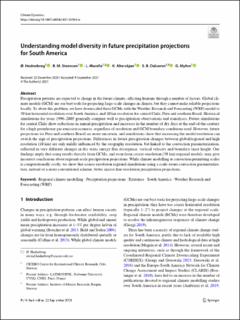| dc.contributor.author | Hodnebrog, Øivind | |
| dc.contributor.author | Steensen, Birthe Marie Rødssæteren | |
| dc.contributor.author | Marelle-Sebrechts, Louis | |
| dc.contributor.author | Alterskjær, Kari | |
| dc.contributor.author | Dalsøren, Stig Bjørløw | |
| dc.contributor.author | Myhre, Gunnar | |
| dc.date.accessioned | 2022-01-27T13:12:01Z | |
| dc.date.available | 2022-01-27T13:12:01Z | |
| dc.date.created | 2021-09-21T11:24:02Z | |
| dc.date.issued | 2021 | |
| dc.identifier.citation | Climate Dynamics. 2021, 1-19. | en_US |
| dc.identifier.issn | 0930-7575 | |
| dc.identifier.uri | https://hdl.handle.net/11250/2889911 | |
| dc.description.abstract | Precipitation patterns are expected to change in the future climate, affecting humans through a number of factors. Global climate models (GCM) are our best tools for projecting large-scale changes in climate, but they cannot make reliable projections locally. To abate this problem, we have downscaled three GCMs with the Weather Research and Forecasting (WRF) model to 50 km horizontal resolution over South America, and 10 km resolution for central Chile, Peru and southern Brazil. Historical simulations for years 1996–2005 generally compare well to precipitation observations and reanalyses. Future simulations for central Chile show reductions in annual precipitation and increases in the number of dry days at the end-of-the-century for a high greenhouse gas emission scenario, regardless of resolution and GCM boundary conditions used. However, future projections for Peru and southern Brazil are more uncertain, and simulations show that increasing the model resolution can switch the sign of precipitation projections. Differences in future precipitation changes between global/regional and high resolution (10 km) are only mildly influenced by the orography resolution, but linked to the convection parameterization, reflected in very different changes in dry static energy flux divergence, vertical velocity and boundary layer height. Our findings imply that using results directly from GCMs, and even from coarse-resolution (50 km) regional models, may give incorrect conclusions about regional-scale precipitation projections. While climate modelling at convection-permitting scales is computationally costly, we show that coarse-resolution regional simulations using a scale-aware convection parameterization, instead of a more conventional scheme, better mirror fine-resolution precipitation projections. | en_US |
| dc.language.iso | eng | en_US |
| dc.publisher | SpringerLink | en_US |
| dc.rights | Navngivelse 4.0 Internasjonal | * |
| dc.rights.uri | http://creativecommons.org/licenses/by/4.0/deed.no | * |
| dc.title | Understanding model diversity in future precipitation projections for South America | en_US |
| dc.type | Journal article | en_US |
| dc.type | Peer reviewed | en_US |
| dc.description.version | publishedVersion | en_US |
| dc.source.pagenumber | 1-19 | en_US |
| dc.source.journal | Climate Dynamics | en_US |
| dc.identifier.doi | 10.1007/s00382-021-05964-w | |
| dc.identifier.cristin | 1936481 | |
| dc.relation.project | Norges forskningsråd: 243942 | en_US |
| dc.relation.project | Norges forskningsråd: 275589 | en_US |
| cristin.ispublished | true | |
| cristin.fulltext | original | |
| cristin.qualitycode | 2 | |

